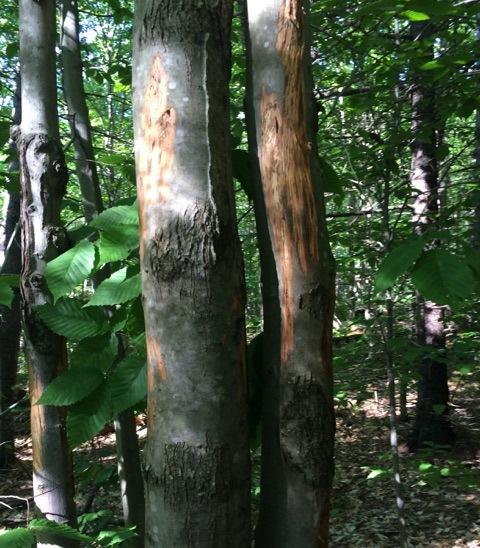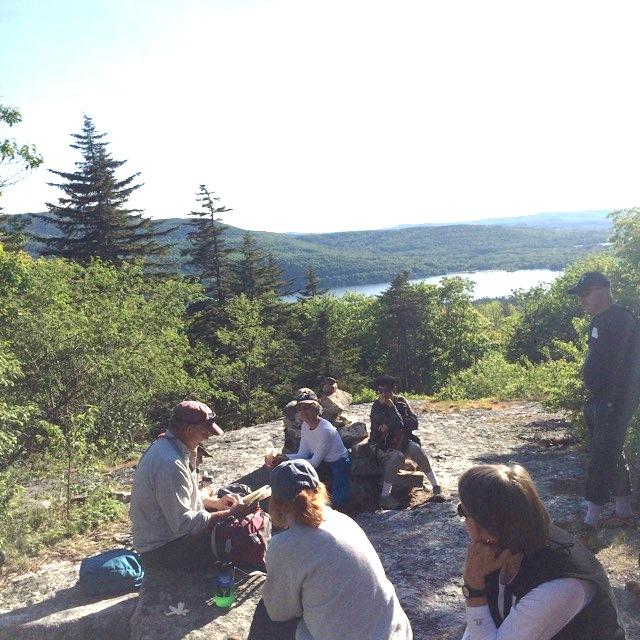A Field Trip at the Hay Forest Reservation & The Fells
- Tags:
- Recreation

Views of Lake Sunapee from the top of this 2.5 mile round-trip hike can be enjoyed by the entire family.
On Wednesday, June 3rd, I was able to join Dave Anderson, Director of Education & Volunteer Services, as he led the first in a three-part series field trip at the Forest Society's Hay Forest Reservation in Newbury, NH. Each year, the Forest Society teams up with The Fells Historic Estate and Gardens to offer natural history field trips. This year's theme is "The Natural and Cultural Land Use History of Sunset Hill."
We gathered at The Fells Gatehouse and Dave Anderson, Director of Education at the Forest Society, introduced himself and the history behind this 718-acre plot of land. He described John M. Hay, a writer and public figure, who bought land along Lake Sunapee, starting in 1888, and used it for his summer cottage. In 1960, under the guidance of John M. Hay's son Clarence, the Hays donated their Sunset Hill property, making it the 6th permanent forest reservation under the management of the Society for the Protection of New Hampshire Forests.
We walked up Old County Road, now a hiking trail, to Sunset Hill, and Dave stopped to pull out a handful of books written by the late naturalist John Hay. John, who spent his summers at the Hay estate with his parents Clarence and Alice, wrote many books highlighting his appreciation and respect for this local landscape. Dave had spent many years walking up these same trails with John Hay and provided insight as to what and where John Hay wrote about. He opened John Hay's "The Immortal Wilderness" and began to read:
The Great hurricane of 1938 cut a swath through inland New England and it hit our lakeside area head on. All those cathedral pines and others pluming by the lake shore for a hundred years or more went down like so many matchsticks. My father, who loved trees, came up from New York where he worked to view the damage, sat down by the road, and cried. But since this a land of trees - in the character and quality of the light they are adapted to, and in cold and stony soil which the old time farmers cleared and plowed - it is also irrepressible.
In some areas where the white pines had grown in on abandoned fields and then been knocked down by the hurricane, they were succeeded by an understory of beech trees, with smooth, silvery gray trunks reminiscent of marine fish, or shining white birch, or sugar maple and ash.
We stopped in the middle of the trail and Dave asked us to look around and describe what we saw. Large beach, sugar maple, and white birch trees towered over us and the remains of an old stone wall lined the ground just ahead.
As we continued, Dave stopped periodically to point out different historical features of this landscape including The Hastings Place Cellar Hole and various stone walls that withstood more than a century of weathering. He also noted the abundance of wildlife that uses this wilderness as their own sanctuary. As we reached the top of the trail, we noticed scratches on a red maple tree from a Moose browsing the bark this past winter.

We reached the top of Sunset Hill, ate our snacks, and looked off into the westward view of Lake Sunapee and the Northern Vermont mountain range, just as Hay Family had done 100 years ago. This spot, accurately named by the family, provided easy access to views and nice rock ledges to enjoy an evening picnic with families and friends. The walk up can be accomplished with small children and the stone walls and cellar holes provide great educational opportunities.
Dave will be continuing this series of field trips on June 17th and 24th with a trip to Beech Brook's Hidden Beaver Ponds and the Lost Farms of Sunset Hill.

Visit our webpage to register for the remaining two field trips today!
For more information on the Hay Estate, please visit our Reservation Guide!
To visit this site and take part in our Reservation Challenge, please visit our webpage!
